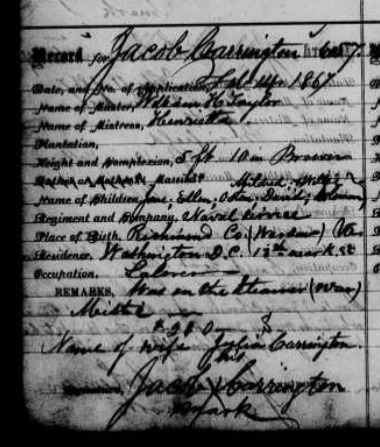Marion Hall was twenty-two in 1920, living at home with her parents and four sisters and working as a milliner in a hat shop. Her parents, both from the Washington D.C./Maryland area, had moved to Massachusetts over twenty years earlier. Her father, Charles, soon found work as a clerk at the post office and remained in that position for over forty years. Her mother, Anna, remained at home with their children, of which they would have six total recorded- the five daughters, Helen, Marion, Ethel, Grace, and Winifred, and a son named Charles who died in 1905 at the age of 9 of pulmonary tuberculosis.
Marion's mother Anna, whose ancestry was unusually well recorded, had been born in about 1867 to parents Jacob and Julia Carrington, who had been enslaved by William H. and Henrietta Taylor, according to an 1867 Freedmen’s Bank record. This record also recorded Jacob’s service on a naval liner during war- most likely, the civil war, after enslaved residents of D.C. were freed in 1862.

Public Domain record via FamilySearch.org.
Marion’s life after 1920 can be partially traced through federal census records. By 1930, she continued to live with her parents, along with her two younger sisters, and was still working as a milliner, though now in a factory. Her father seems to have died between 1930 and 1940, at which time she was living with only her mother and youngest sister, still working at a factory. She does not seem to have ever married, and lived a long life in Boston, dying at age 91 in 1989.
Marion and her sisters overall had high education levels for the time, most likely made possible because of her father’s steady work as a clerk for the post office. A stable, relatively high income meant that even in a large family, all the children could stay in school. Marion and her sisters were able to complete all four years of high school, and the second youngest, Grace, also completed two years of college. While Marion consistently worked as a milliner, her sisters held jobs such as stenographer, typist, or teacher. The eldest, Helen, worked as a stenographer at the state house in Boston in 1920.
Notes
- “Roll 4, July 11, 1865-Dec 30, 1871, image 120 of 841” in United States, Freedman's Bank Records, 1865-1874, accessed via FamilySearch.org https://familysearch.org/ark:/61903/3:1:S3HY-X4XZ-N6?cc=1417695&wc=3MDR-RM9%3A1551794703%2C1551800972.
- “Marion L. Hall, 1989,” Massachusetts Death Index, 1970-2003, accessed via FamilySearch.org https://familysearch.org/ark:/61903/1:1:VZRY-7GH.
- “Edward Smith Davis and Helen Virginia Hall, 19 Apr 1920,” in Massachusetts Marriages, 1841-1915, accessed via FamilySearch.org https://www.familysearch.org/ark:/61903/1:1:Q28K-56C7.
- U.S. Census Bureau; Ninth Census of the United States, 1870. Accessed via Ancestry.com https://www.ancestrylibrary.com/search/collections/7163/.
- U.S. Census Bureau; Fourteenth Census of the United States, 1920. Accessed via Ancestry.com https://www.ancestrylibrary.com/search/collections/6061/.
- U.S. Census Bureau; Fifteenth Census of the United States, 1930. Accessed via Ancestry.com https://www.ancestrylibrary.com/search/collections/6224/.
- U.S. Census Bureau; Sixteenth Census of the United States, 1940. Accessed via Ancestry.com. https://www.ancestrylibrary.com/search/collections/2442/.